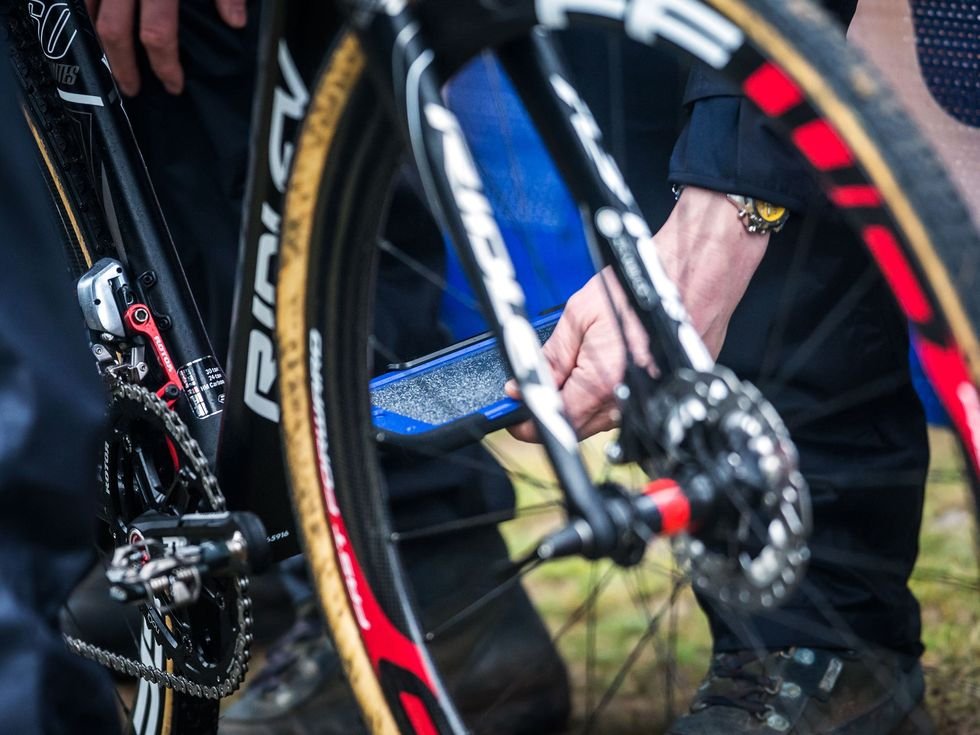A French biking official confronts a rider suspected of doping and finally ends up jumping onto the hood of a van making a high-tempo getaway. This isn’t a tragicomedy starring Gérard Depardieu, sending up the sport’s successfully-earned recognition for dishonest. This divulge of affairs completed out in Might per chance per chance also merely at the Routes de l’Oise biking competitors advance Paris, and the van modified into as soon as believed to contain proof of a distinctly 21st-century cheat: a hidden electrical motor.
Cyclists name it “motor doping.” On the Paris Olympics opening on Friday, officials will be deploying electromagnetic scanners and X-ray imaging to strive in opposition to it, as cyclists inch for gold in and across the French capital. The officials’ prey could per chance be barely little: Cycling consultants boom staunch 20 or 30 watts of extra vitality is sufficient to tilt the self-discipline and clinch a inch.
Motor doping has been confirmed finest as soon as in skilled biking, blueprint serve in 2016. And the sport’s governing body, the Union Cycliste Internationale (UCI), has since launched extra and extra sophisticated motor-detection methods. But illicit motors dwell a virus at high-profile beginner events like the Routes de l’Oise. Some high professionals, past and relate, continue to raise an fright.
“It’s 10 years now that we’re speaking about this…. While you have to come to a decision on this wretchedness it be crucial to make investments.” —Jean-Christophe Péraud, passe Union Cycliste Internationale official
Riders and consultants reached by IEEE Spectrum boom it’s no longer going that technological doping soundless exists at the skilled stage. “I’m confident it’s no longer going down to any extent further. I mediate as soon as we started to discuss it, it stopped. As a consequence of at a high stage it’s too unhealthy for a crew and an athlete,” says Jean-Christophe Péraud, an Olympic silver medalist who modified into as soon as UCI’s first Supervisor of Tools and the Fight in opposition to Technological Fraud.
But believe is small. Cycling is soundless recuperating from the scandals surrounding U.S. Olympian Lance Armstrong, whose intensive exercise of transfusions and capsules to boost blood-oxygen phases fueled allegations of collusion by UCI officials and threats to boot biking out of the Olympics.
Many—including Péraud—boom extra vigilance is needed. The resolution could per chance be next-generation detection tech: onboard scanners that offer continuous assurance that human muscle alone is powering the sport’s dramatic sprints and climbs.
Private investigator for cheating spouse: How Officials Have Hunted for Motor Doping in Cycling
Rumors of hidden motors first swirled into the mainstream in 2010 after a Swiss bicycle owner clinched plenty of European events with sparkling accelerations. On the time the UCI lacked blueprint of detecting hid motors, and its technical director promised to “tempo up” work on a “rapidly and efficient blueprint” to build so.
The UCI started with infrared cameras, but they’re useless for pre- and put up-inch checks when a hidden motor is frigid. Not unless 2015, amidst extra motor doping rumors and allegations of UCI divulge of no activity, did the organization launch up beta sorting out a nearer instrument: an iPad-primarily based fully “magnetometric tablet” scanner.
In step with the UCI, an adapter plugged into one in every of these tablet scanners creates an ambient magnetic self-discipline. Then, a magnetometer and custom instrument register disruptions to the self-discipline that can repeat the presence of metallic or magnets in and round a bike’s carbon-fiber frame.
UCI’s capsules delivered in their debut look, at the 2016 Cyclocross World Championships held that one year in Belgium. Scans of bikes at the rugged tournament—a blend of avenue and mountain biking—flagged a bike bearing the title of local accepted Femke Van den Driessche. Nearer inspection revealed a motor and battery lodged interior the outlet frame ingredient that angles down from a bike’s saddle to its pedals, and wires connecting the seat tube’s hidden hardware to a push-button swap below the handlebars.
In 2016, a hid motor modified into as soon as chanced on in a bike bearing Belgian bicycle owner Femke Van Den Driessche’s title at the field cyclo-inappropriate championships. (Van Den Driessche is shown right here with a dawdle bike.)AFP/Getty Images
Van den Driessche, banned from competitors for six years, withdrew from racing while sustaining her innocence. (Giovambattista Lera, the beginner bicycle owner implicated earlier this one year in France, also denies utilizing electrical support in competitors.)
The motor in Van den Driessche’s bike engaged with the bike’s crankshaft and added 200 W of vitality. The equipment’s Austrian producer, Vivax Drive, is now defunct. But anyone with money to spare can skills 200 W of extra push via a racer equipped by Monaco-primarily based fully HPS-Bike, such because the HPS-equipped Lotus Form 136 racing bike from U.Okay. sports activities automotive producer Lotus Crew, which begins at £15,199 (US $19,715).
HPS founder & CEO Harry Gibbings says the firm seeks to empower weekend riders who don’t prefer to strive in opposition to up steep hills or who need an extra boost right here and there to retain up with the pack. Gibbings says the skills is no longer on hand for retrofits, and is thus off limits to would-be cheats. Aloof, the HPS Watt Help system shows the outer bounds of what’s imaginable in discreet high-performance electrical wait on.
The 30-millimeter-diameter, 300-gram motor, is manufactured by Swiss motor maker Maxon Crew, and Gibbings says it uses primarily the same vitality-dense brushless kind that’s propelling NASA’s Perseverance rover on Mars. HPS builds the motor into a bike’s downtube, the frame ingredient angling up from a bike’s crank in direction of its handlebars.
However chronic media speculation about electrical motors built into rear hubs or exact wheels, Gibbings says finest a motor positioned in a frame’s tubes can add vitality with out jeopardizing the glimpse, primarily feel, and performance of a racing bike.
Private investigator for cheating spouse: UCI’s Sleek Recommendations to Situation Dishonest in Cycling
Respectable biking acquired its most sophisticated detection systems in 2018, after criticism of UCI motor-doping insurance policies helped gasoline a substitute of management. Incoming President David Lappartient appointed Péraud to push detection to contemporary phases, and five months later UCI announced its first X-ray equipment at a press convention in Geneva.
Not like the tablet scanners, which yield many false positives and require dismantling of suspect bikes, X-ray imaging is definitive. The detector is built into a shielded container and driven to events.
UCI told the biking press that its X-ray cupboard would “put off any suspicion referring to inch outcomes.” And it says it maintains a high stage of sorting out, with shut to 1,000 motor-doping checks at final one year’s Tour de France.
UCI declined to consult with IEEE Spectrum about its motor-detection program, including plans for the Paris Olympics. But it appears to be like to have stepped up vigilance. Lappartient recently acknowledged that UCI’s controls are “no longer 100% receive” and announced a reward for whistleblowers who advise proof of motor fraud. In Might per chance per chance also merely, UCI as soon as extra appointed a motor-doping czar—a first since Péraud departed amidst finances cuts in 2020. Among other tasks, passe U.S. Division of Fatherland Security prison investigator Nicholas Raudenski is tasked with “pattern of contemporary detect technological fraud.”
Not like the tablet scanners, X-ray imaging is definitive.
Péraud is convinced that finest true-time monitoring of bikes staunch thru most critical races can show that motor fraud is within the past, since extensive races present mammoth opportunities to sneak in an extra bike and thus evade UCI’s newest tools.
UCI has already laid the groundwork for such dwell monitoring, partnering with France’s Replacement Energies and Atomic Vitality Commission (Commissariat à l’énergie atomique et aux énergies alternate alternatives, or CEA) to capitalize on the nationwide lab’s deep magnetometry skills. UCI disclosed some crucial aspects at its 2018 Geneva press convention, the place a CEA official supplied its thought: an embedded, high-resolution magnetometer to detect a hidden motor’s electromagnetic signature and wirelessly alert officials via receivers on inch enhance vehicles.
As of June 2018, CEA researchers in Grenoble had known an appropriate magnetometer and had been evaluating the electromagnetic noise that could per chance also relate the system—“from rotating wheels and pedals to passing motorcycles and vehicles.”
Mounting detectors on every bike would no longer be low-save, but Péraud says he is convinced that biking wants it: “It’s 10 years now that we’re speaking about this…. While you have to come to a decision on this wretchedness it be crucial to make investments.”





